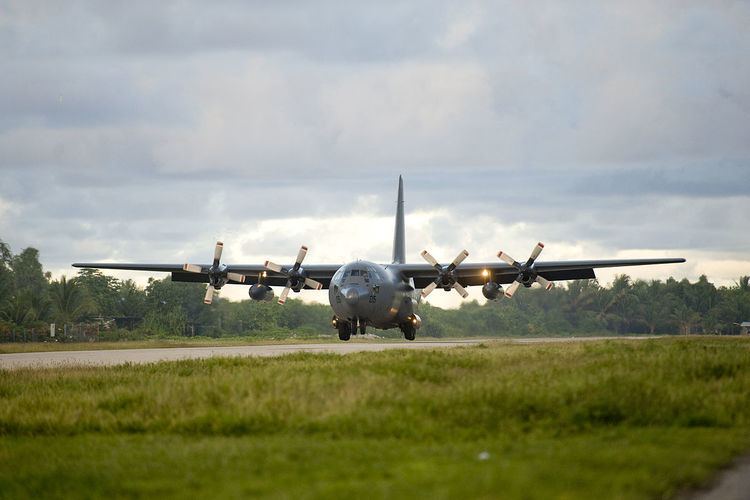Airport type Public Elevation AMSL 9 ft / 3 m 1,524 5,000 Code FUN | 3/21 1,524 5,000 Paved Elevation 3 m Phone +90 531 244 02 38 | |
 | ||
Funafuti international airport taxiing to runway
Funafuti International Airport (IATA: FUN, ICAO: NGFU) is an airport in Funafuti, in the capital city of the island nation of Tuvalu. Fiji Airways (trading as Fiji Link) operates three flights a week between Suva (originating from Nadi) and Funafuti with ATR 72-600 aircraft that have a capacity of 68 passengers and cargo.
Contents
- Funafuti international airport taxiing to runway
- History
- Facilities
- Airlines and destinations
- References
History
Funafuti Airport was built by a detachment of the 2nd Naval Construction Battalion (Seabees) of the United States Navy in 1943 during World War II.
The military airfield included an airstrip, control tower and facilities, with a radio station at Tepuka, connected by cable to the airfield. The base headquarters buildings were at the present-day Teagai Apelu's residence, and a bunker is there to this day.
The first offensive operation was launched on 20 April 1943 when 22 B-24 Liberator aircraft from 371 and 372 Bombardment Squadrons bombed Nauru. The next day the Japanese made a predawn raid on the strip at Funafuti that destroyed one B-24 and caused damage to five other planes. On 22 April, 12 B-24 aircraft bombed Tarawa. Marine Fighting Squadron 441 (VMF-441), flying the F4F Wildcat, operated from Funafuti from May to September 1943.
The airfield became the headquarters of the United States Army Air Forces VII Bomber Command in November 1943, which directed operations against Japanese forces on Tarawa and other bases in the Gilbert Islands. The USAAF stationed two B-24 Liberator heavy bomber groups, the 11th Wing and 30th Bombardment Groups on Funafuti in the implementation of Operation Galvanic, which led to the Battle of Tarawa and the Battle of Makin in November 1943.
By the middle of 1944, as the fighting moved further north toward Japan, the Americans began to withdraw. By the time the Pacific War ended in 1945, nearly all of them, with their equipment, departed. After the war, the military airfield was developed into a commercial airport.
Facilities
The airport is at an elevation of 9 feet (3 m) above mean sea level. It has one runway which is 1,524 metres (5,000 ft) in length. The absence of runway lighting, minimal VHF radio and air navigation equipment means that operations are restricted to daylight hours.
The runway was originally constructed using coral aggregate and has a sub-base layer of 8 cm thick coral gravel, surfaced with a 1–2 cm asphalt chip seal. It was resurfaced in 1992 and the runway was rated at 50 tonnes landing capacity; it was reduced to 20 tonnes landing capacity due to sub-surface water, deterioration of the sub-base and lack of surface maintenance. However, the runway was resurfaced in 2015 so that the pavement would be re-rated.
The deterioration of the runway's sub-base is a consequence of its low elevation and the hydrologic dynamics in the sub-surface of the atoll. There was extensive swamp reclamation during World War II to create the airfield. About half of Fongafale islet is reclaimed swamp that contains porous, highly permeable coral blocks that allow the tidal forcing of salt water through the sub-base of the runway. This results in salt water pooling on the runway during spring tides.
In November 2013 the World Bank approved US$6.06 million in finance for the existing Tuvalu Aviation Investment Project (TvAIP) for the purpose of improving operational safety and oversight of international air transport and associated infrastructure at Funafuti International Airport. TvAIP was implemented in 2015 in order that the runway achieve a minimum pavement classification number (PCN) of 18 to provide a load-carrying capacity of the pavement that rates the runway for emergency flights. TvAIP also involved improvements of navigational aids and other safety and security facilities to meet International Civil Aviation Organisation (ICAO) requirements.
The airport is somewhat unusual in that due to limited space on the island, the runway is used more as a common area for sporting and social activities when it is not in use. Sirens sound when a plane is about to land, warning residents to stay off the runway.
Airlines and destinations
Up to 1999 Air Marshall Islands operated a Hawker Siddeley HS 748 with a passenger load of 55. In 2001 the government purchased a share of Air Fiji in 2001, which provided Tuvalu with greater control of its airline access; however, Air Fiji ceased operations in 2009.
Fiji Airways, the owner of Fiji Airlines (trading as Fiji Link) operates services 3 times a week (Tuesday, Thursday and Saturday) between Suva (originating from Nadi) and Funafuti with ATR 72-600, a 68-seat plane.
In February 2015 Samoa Air and Coral Sun Airways, of Kiribati announced their intention to provide regular flights to Funafuti in 8 seater aircraft.
